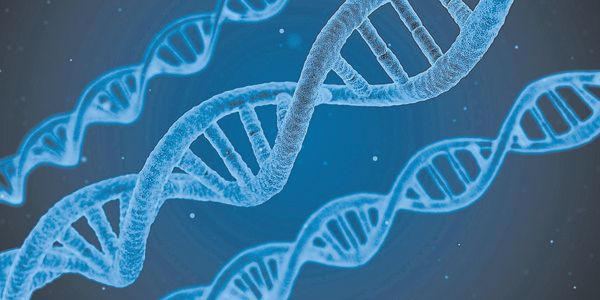
‘Early man was late for first date’, ran the newspaper headline: ‘Women were the complete article long before men, a new study has shown … The result overturns the biblical description of women being created from a spare rib left over from a man’ (The Times, 31 October, p.11).
The reporter has got his Chinese take-away mixed up with his book of Genesis, but I will pass over that. What is important is that the Bible’s account of man’s origin is again under fire.
Why? If science has established so convincingly that man evolved from ape-like ancestors, and Adam and Eve have been consigned to the trash-can of mythology, why should anyone bother to attack the Bible’s version of events?
The answer, surprisingly, is that man’s evolution is far from proven. The whole theory of evolution is, in fact, under attack. From creationists? No, from serious scientific thinkers.
Implausible
One problem for evolution is that its ‘proofs’ are often implausible. Let us return to the study in The Times.

An international team examined DNA from the Y chromosome of 1000 men from 22 parts of the world. Males have a Y chromosome and an X chromosome, located in the nuclei of the cells of which our bodies are composed. Females have two X chromosomes. It is the Y chromosome, therefore, that confers ‘maleness’.
There are small differences in the DNA of people from different backgrounds, and these are believed to have arisen, over the course of time, by random genetic mutations. Researchers assume that these mutations take place at a constant average rate, perhaps one every 600 generations in a given gene.
By comparing a large number of males from different backgrounds, the researchers calculated that they all derived from a common ancestor who lived 59,000 years ago (the geneticists’ Adam!).
Ancient Eve
A similar study was carried out earlier on women. The DNA examined, however, was not from the X chromosome but from ‘mitochondria’, small bodies that exist in cells outside the cell nucleus. Most of this mitochondrial DNA is passed on by the female during reproduction.
Differences in mitochondrial DNA from various parts of the world allow an age to be worked out for the single female from whom all women appear to have descended. The geneticists’ Eve turns out to be 143,000 years old, 84,000 years older than Adam!
The researchers infer that during the 84,000 years between ‘Eve’ and ‘Adam’, females were fully human but males were not. Or, to put it differently, a race of sub-human males lived for 84,000 years who left no trace of their existence in the human genome, at the same time as their females did leave such a trace! (The genome is the total pool of genetic information in a species.)
Assumptions
This conclusion is contrary to common sense. In scientific jargon, it is intrinsically implausible. Normally, when this sort of problem arises, scientists re-examine their methods and assumptions. But with this kind of research it is impossible to check the assumptions.
The first assumption is that human DNA undergoes genetic mutations at a particular rate. Once a mutation frequency has been assumed, the mutational differences observed can be ‘translated’ into a number of generations since our first parent(s) were alive.
But the mutation rate in human DNA has seldom been measured. What measurements there are, suggest a much larger mutation rate than is normally assumed.
Mutation rates can be measured in species, like the fruit-fly, where large numbers of generations can be bred over a short period of time. But scientists know that the rates can vary greatly between species (and even between different chromosomal sites within a species).
More usually, the supposed evolutionary time-scale itself is used to estimate mutation rates, creating a completely circular argument. The fact is that the ‘ages’ calculated for our first parents are wholly speculative.
More assumptions
What if the researchers have guessed their mutation rates correctly? They next assume that these rates have not changed over tens of thousands of years. This is almost certainly wrong.
No one really knows why mutations occur in a natural population. Artificially, mutations can be induced by chemicals and radiation. Natural mutations can, therefore, be caused by background radiation from cosmic rays or natural radioactivity.
Some genetic mutations occur spontaneously, without any external cause, when ‘mistakes’ are made during DNA replication. But the fact that mutations are rare shows that living cells possess efficient repair mechanisms.
Perhaps, therefore, the problem lies in a failure of these mechanisms. Furthermore, many mutations are ‘weeded out’ because they reduce viability. No one really knows the mutation rates that would apply to humans over vast periods of time.
A final unjustified assumption is that mutation rates are the same for nuclear DNA and mitochondrial DNA. There is evidence that this is not the case. It might be true if mutations are caused by external agencies like background radiation, and if repair mechanisms are identical in the two types of DNA. But these are big ‘ifs’.
Biblical account
The unlikely conclusion reached by the study stands in stark contrast to the straightforward and rational claim made in Genesis. According to the Bible’s account, the whole human race arose from a single pair, Adam and Eve, the first humans.
Ironically, before studies like the one discussed were possible, the idea of a first man and woman was ridiculed by evolutionists. They thought that mankind evolved as a large population and that there were no unique parents of the human race.
Now, at least, they must accept that the existence of a ‘first man’ and a ‘first woman’ is consistent with their own research. But they still maintain that their ‘Adam and Eve’ were preceded by a race of sub-human creatures which evolved into modern man. What evidence do they have? Precious little, is the answer.
Apes and men
This may come as a surprise, fed as we are with an unremitting diet of TV programmes, magazine articles and books on evolution and ‘the descent of man’. But, in reality, most of what we are told is speculation based on the assumption that evolution is true. What are the facts?
For over a hundred years, anthropologists have searched for the ‘missing link’ between apes and man. Only a very few candidates have emerged. They have been given scientific-sounding names such as Proconsul, Ramapithecus, Australo-pithecus, Homo habilis, Homo erectus, andHomo neanderthalis. These creatures, we are told, stand in the direct lineage of modern man.
But the fact is that these supposed ‘ancestors’ of mankind are either extinct apes or true humans. Indeed, the term ‘pithecus’ is the Latin for ‘ape’ and means that the animal concerned was just that – an ape. On the other hand, for example, Neanderthal man was fully human, with a brain size equal to that of modern man.
Reconstruction
Consider the creature called Ramapithecus. I cannot show you a picture of this species because the only remains available are a small number of teeth, a few jaw fragments and a palate (with teeth) which is alleged to have a human shape.
Discovered in the early 20th century, Ramapithecus is still featured in school text books as a precursor of man. This is largely on the basis that the reconstructed palate looks more human than ape-like. However, the word ‘reconstructed’ is important.
The palate is not complete but consists of two unconnected fragments. The angle between these fragments is unknown and has to be guessed by whoever does the reconstruction. Yet the supposed similarity to a human palate depends entirely on the angle set between the pieces!
Most experts today consider that Ramapithecus is, in fact, a kind of orangutan and not a human ancestor. But some still maintain that it is an antecedent of man. People are entitled to their opinions, but readers will judge for themselves whether the edifice of human evolution can stand on such flimsy foundations.
For other examples see a new booklet Is man descended from Adam? published by the Biblical Creation Society (BCS on www.pages.org).
Created in God’s image
Man is unique among the creatures of this world. Even evolutionists recognise this fact. Where the Bible differs is in its claim that mankind has always been distinct from animals. Of course, we share with animals many physical characteristics, from brains to DNA. But this only tells us that the Creator used a common pattern for living things.
Man differs from the animals in two outstanding ways: his unique mental capacity and his moral and spiritual nature. In these respects man was made ‘in the image of God’ (Genesis 1:27). This has important implications for each one of us.
If we are simply highly evolved animals, then there is no purpose behind our existence, nor are we morally responsible for the way we live. But if we were created by God to share his ‘image’, we are responsible to him and must answer to him for what we do.
The Bible says that God will one day judge all people for their sins. The gospel of Jesus Christ, explained elsewhere in this paper, tells us how we may escape that judgement and be reconciled to our Creator and our God.




